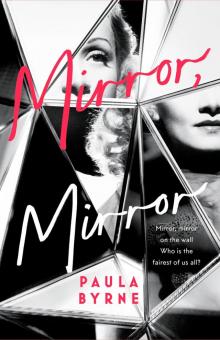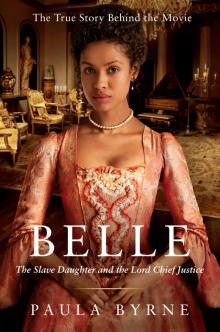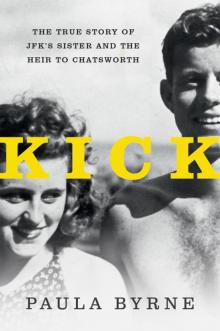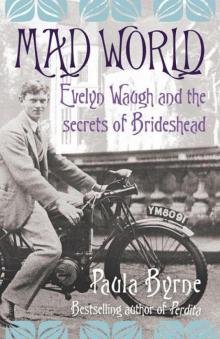- Home
- Paula Byrne
The Adventures of Miss Barbara Pym Page 3
The Adventures of Miss Barbara Pym Read online
Page 3
In ‘Young Men in Fancy Dress’ the heroine complains of being bored in the company of ‘hopelessly stupid’ girls, who ‘can’t talk about anything but dances, or golf, or tennis – they don’t seem to have read any decent books and if they have – they can’t discuss them with any intelligence’.[2] Whether or not this sentiment echoed her own feelings, Pym certainly was ready to flirt and fall in love. Even before Oxford, she had developed a crush on a young bank clerk in Shropshire. His name was John Trevor Lloyd and she composed two poems in his honour – one of them called ‘Midland Bank’, dedicated ‘to JTL with the author’s fondest love (but without his permission)’.[3]
Eighteen-year-old Barbara was a tall, attractive young woman, with an engaging lopsided smile and thick, wavy chestnut-coloured hair. More than one person described her as having a ‘Joyce Grenfell’ look about her, perhaps because of her height, her ungainliness and her habit of clowning around and making jokes. She was not conventionally beautiful or delicate-looking, but she was always well dressed and well turned out. In one of her early stories, the heroine, Flora, is a thinly disguised version of Pym, described as ‘a tall big-boned girl with a fresh complexion and large, bright, intelligent grey eyes’. She has light brown hair with golden streaks and a broad mouth, ‘always laughing or smiling’.[4]
When Pym went up to St Hilda’s, it was still a small college. She had prepared herself for undergraduate life by reading Oxford novels and the poetry of Matthew Arnold, but none of these was written about the five women’s colleges, or indeed from the female perspective. St Hilda’s – its motto non frustra vixi (I lived not in vain) – had the atmosphere of a girls’ private school. Founded in 1893, the college sits on the River Cherwell, overlooking Magdalen Bridge and Christ Church Meadow. Its location in a tranquil nook of Oxford gave it a cosy, intimate atmosphere. The lawn sloped down to the river, where girls could sit in the summer and read – though they were forbidden to place teapots on the lawn (one of many prohibitions in the undergraduate handbook).
Oxford clung to its old traditions and it must have felt to the young girl from the north of England like another world. Then, as now, colleges were the centre of social life and each college had its own identity. There were divisions and cliques within and between the colleges; northerners and southerners viewed each other with suspicion, as did public school and grammar school undergraduates, hearties and aesthetes. In 1931, the year Pym arrived, an undergraduate poet had his rooms trashed and the following year, another student – with ‘Oscar Wildish propensities’ – had his grand piano smashed up and his clothes thrown on a bonfire.[5]
Rules dated back to ancient times. Black gowns had to be worn, chapel attended, gate hours kept. Most societies remained male preserves. Individual women were allowed to act with the Dramatic Society (OUDS) by invitation only.[6] Male dining clubs flourished and were riotous events resulting in shattered windows, broken furniture and damaged flowerbeds. Undergraduates were treated like grown-up children and lived in an environment that replicated public school life: they were expected to keep to gate hours, allowed to mix socially with the opposite sex only under the strictest conditions and were banned from visits to the public houses. The women were referred to as ‘young ladies’, the men as ‘gentlemen’. Gowns had to be worn when in town, and hemlines were low.
St Hilda’s was a particularly strict college, with firm rules about gentlemen callers. Undergraduates were permitted to receive gentleman friends not related to them on Tuesday afternoons only. The gates closed at 9.10 p.m. As late as the 1990s, students had to write down the name of their gentleman visitors, and if they stayed the night that information had to be submitted to the porter’s lodge. Women were not free to mix as they pleased. It was not until 1935, after Pym had left Oxford, that a female student could visit a male undergraduate in his rooms unaccompanied by another female, and even then she had to leave before evening hall.
Punishment was fierce for transgressions of rules – particularly so for women. The college authorities had three weapons: fines, gating (being confined to college), and rustication (being temporarily sent home). As late as 1961, St Hilda’s expelled a female undergraduate discovered with a man in her room after the gates had closed.[7] At St Hugh’s, if a female student had a male visitor, the bed was ceremoniously wheeled out of her room and into the corridor.[8] But, of course, when young people of the opposite sex are in close proximity, rules are circumvented, codes of conduct are relaxed, especially when alcohol is added to the mix. Barbara Pym was determined to taste, in Evelyn Waugh’s words, ‘all the delights Oxford had to offer’.[9]
CHAPTER VI
In which our Heroine might have said Et in Arcadia ego
Despite its restrictions, St Hilda’s was a warm and friendly college. The dining hall, furnished with long tables and benches, adorned in the evenings with glistening silver and lit by candlelight, overlooked the River Cherwell. Barbara Pym’s room was on the top floor, with her own view of the river and the long, sweeping drive. She made friends easily and would chat with her fellow students long into the night.[1] Her closest friends were Mary Sharp, Dorothy Pedley and Rosemary Topping, always referred to by their surnames.
Compared with her schoolgirl days, there were freedoms to be enjoyed: a room of one’s own, financial independence, no more school timetables or school uniform. Clothes were an abiding passion for Pym and before coming up to Oxford she had planned a whole new wardrobe. Like many young women of her class and era, she sewed most of her own clothes. Shop-bought dresses were a luxury item.
Pym found Oxford ‘intoxicating’.[2] In no small part this was because she suddenly found herself the centre of male attention and, like many girls from single-sex schools, she was ready to enjoy being in the company of young men. As with her heroine, Miss Bates, in her third published novel Jane and Prudence, the male undergraduates beat a path to Pym’s door. It was not only the preponderance of men (the ratio was one woman to ten men) that enhanced her desirability, but also the fact that she was so funny and interesting. She was in particular a magnet for homosexual men, who were drawn to her wit and playfulness.
Barbara never forgot the heady days of her first term at Oxford; the city seemed at its most beautiful in the autumn months. In her novel, Jane and Prudence, she pays tribute to the feelings evoked by her earliest impressions of the university in the Michaelmas term: ‘the new work, the wonderful atmosphere of Oxford in the autumn, the walks up to Boars Hill and Shotover and all those lovely berries we used to gather’.[3]
The first term was spent getting to know her new surroundings, smoking Gold Flake cigarettes and listening to jazz bandleader Jack Payne on the wireless. There was an active social life at Oxford revolving around sherry parties, tea parties, dinners and the theatre. Above all, Barbara loved watching films and took advantage of Oxford’s several picture houses: ‘the Queener’ on Queen Street, ‘the Walton Street’ cinema, which showed French films, and, up a steep hill, the Headington cinema, where the students cycled, storing their bikes in the yard of the nearby fish and chip shop.
Barbara spent most of her studying hours at the Bodleian Library, a prime place for spotting handsome undergraduates. The oldest reading room, the Duke Humfrey’s library on the first floor, was a beautiful room built in the shape of an H. Humphrey, Duke of Gloucester, who was the youngest son of King Henry IV, donated his collection of 281 books to the Bodleian in 1447. At the time, the library had only twenty books and a new reading room was built to house the collection. Readers were compelled to recite aloud a promise not to burn books, a reference to the burning of most of the duke’s collection during the Reformation. Pym would have recited the pledge: ‘I hereby undertake not to remove from the Library, or to mark, deface, or injure in any way, any volume, document, or other object belonging to it or in its custody; not to bring into the Library or kindle therein any fire or flame, and not to smoke in the Library; and I promise to obey all rules of the Library.’
On
the second floor of the Old Library was the Upper Reading Room, which housed the principal collected of printed books published after 1640, in the subject fields of medieval and modern history and English language and literature. The Lower Reading Room housed classics and ancient history, theology and philosophy. It is partitioned into smaller rooms. The central Tower Room had a glass-fronted portrait of Geoffrey Chaucer. Pym used the portrait as a mirror to comb her hair and apply her lipstick – a habit she later gave to the heroine of Some Tame Gazelle, though she edited it out of the published version.
Though she allowed undergraduate men to pay court, she developed crushes on the youthful dons, known as ‘examination moderators’, who set and marked the exams. She invented a game called ‘Spot the Moderator’. She nicknamed her favourite moderator ‘Fat Babyface’. She loved to stalk him through the streets of Oxford. Another was ‘Ruffled Chicken’.
Indeed, Barbara was enjoying life so much that she failed her end of term examinations. It was a shock, and made her resolve to be more diligent and studious. Being home for Christmas only increased her sense of dismay. Oxford was a new world, and back in the wilds of Shropshire she realised that she must not squander her precious gift. She needed to work hard through the holidays in order to resit her exams.
Another resolution was to begin a new diary. Barbara had written a diary as a schoolgirl, which she probably destroyed. From this point on, though, she kept all her diaries. She titled her Oxford diary: ‘A Record of the Adventures of the celebrated Barbara M C Pym during the year 1932 (written by herself)’ – a satirical nod to the picaresque adventurers of eighteenth-century novels such as Tom Jones and Moll Flanders.
CHAPTER VII
In which Miss Pym returns North
Pym’s first diary entry is short: ‘Up at 9.30. No post at all.’[1]
She was hankering for her university friends – just as in Brideshead Revisited, hero Charles Ryder sits at home, melancholy, after his first term at Oxford, desperate for a letter from Sebastian Flyte. Oxford seemed a long way away. ‘Beginning the year in an excellently one-sex way,’ she wrote, in partial relief after the drama of her first term and the excitement of being the centre of male attention: ‘Went to Blackgate – no thrills there.’[2]
Life back in Shropshire seemed mundane: eating, sewing, flicks in the evening. She was happy to see her sister and parents, but she now felt the slow pace of home: ‘A spot of supper and a domesticated evening. Myself a little desirous of somewhere else.’ She felt ‘vague’ and listless, with a sense of dislocation that was difficult to shrug off. She began to be alienated from her Shropshire friends, who felt that university life was giving her ‘airs’. Even her mother noted a change in her daughter, whose heart was back in Oxford.
In another unfinished novel, ‘Beatrice Wyatt’, Pym wrote about her heroine’s disoriented feelings about being back in her old bedroom. She comes home from Oxford for the holidays and wakes up to the same old schoolgirl’s bedroom. The pale yellow walls are hung with reproductions of Cézanne and Van Gogh. Her white bookshelves are lined with old novels, such as ‘blue phoenix’ copies of Aldous Huxley and books that she has now outgrown and is ‘partly ashamed’ of having once loved. There is a chintz ottoman in the corner of the room in which old essays and stories are stored.
One suspects that Beatrice is also ‘partly ashamed’ of her dull home life and the mother who tries so hard to please but is irritating and vague, obsessed by her bridge parties. Oxford is far more alluring than the countryside.[3] Beatrice has installed a gas ring for ‘private cups of tea’ whilst she works hard at her studies, but is interrupted by her mother, who urges her clever, distant daughter to not work so hard, but to listen to the wireless instead.[4]
There is scarce mention of Barbara’s family in her journal at this time, other than a passing reference to them taking her to the station. Thrilled as she was to be leaving Shropshire, she was mindful of her precarious position, having to resist the temptations of her active social life and resit her examinations: ‘I’m looking forward awfully to going back – but simply must work hard,’ she confided. On 12 January 1932 she packed for Hilary term, taking with her her favourite doll, Wellerina – ‘made presentable to make her debut at Oxford – may she bring me luck’.[5] Like the fictional Sebastian Flyte’s teddy bear in Brideshead Revisited, Wellerina seems to have caused quite a stir amongst her Oxford friends.
CHAPTER VIII
In which Miss Pym returns to Oxford
Somehow, at Oxford station, Pym left the train with the wrong suitcase, which belonged to a boy at Lincoln College, a Joyce Grenfell kind of misadventure.[1]
Despite her determination to work hard, she was ‘goofy with excitement’, her head still full of boys: ‘A new term in a new year – golden opportunities (and how!) to get a Moderator, a peer’s heir, a worthy theological student – or even to change entirely!’ She was determined to find out the name of the moderator who had ‘ploughed’ her (failed her examination paper). She discovered that it was probably ‘G Moore of Magdalen’. Mary Sharp, Pym’s best friend, had also been ploughed, making her feel less humiliated. Could G. Moore be her beloved ‘Fat Babyface’? She resolved to further her investigations. Her female friends were dismayed by her choice of crush, but she found him chatting to an undergraduate in Blackwell’s bookshop, ‘Too sweet, in spite of other people’s unfavourable opinions.’[2]
Pym kept up her other ‘secret passion’ for a boy from ‘Teddy Hall’ (St Edmund’s), whom she had spotted at St Mary’s, the university church. Rather thrillingly, he was not wearing his gown. She felt he had an ‘interesting face … I’m sure he must be worthwhile.’ Back in her room, she consulted the University Calendar, which provided her with a comprehensive list of all students.[3]
The next day, Pym observed Fat Babyface buying a second-hand record, but it was too late to shadow him. Instead, she went to a Bach concert and on the way home saw her ‘pet scholar’ from St Edmund’s Hall, so she ‘traced’ him up the Iffley Road in order to discover his lodgings, so she could eventually discover his name. There were men all around who were ready and willing to be flirted with: Teddy, Trevor, Harry, Bill and Gary, Ross and Aidan, John (‘his hair so beautifully golden and about twice as long as last term’). ‘Ruffled Chicken moderator’ turned out to be Herbert J. Hunt: ‘He has a Lancs accent and one feels that his H’s are more a matter of luck than habit.’[4] She had found out that it was he who had ploughed her: ‘I don’t think I have the heart to murder him.’ Then there was Monkey, ‘a funny old darling’, whose first comment on meeting Pym was: ‘How foul you look.’[5]
And still the men came. A chap called Harlovin asked her for a date. Bill and Stephen walked her back to St Hilda’s. After parting from them at the college gates, she went to her room and undressed in the ‘dim religious light of two candles’.[6] The next day she spotted her ‘pet moderator’. She pondered on whether he was even aware of her existence: ‘Really this is the queerest crush ever – I wonder if he has any inkling.’ She was thrilled to see the suspicion of a red silk hanky peeping out of his top pocket: ‘Who says they [moderators] aren’t human!’[7] Much of the thrill was in the chase. Pym was too self-aware not to see this aspect of her attraction to unavailable men.
Teddy often took her to tea at Elliston & Cavell, known as Elliston’s, the largest department store in Oxford (later taken over by Debenhams). It was lavishly decorated with a sweeping staircase and a mural depicting deer in a forest glade. The ladies’ powder room boasted gold taps and marble basins in the shape of swans. Attendants dressed in black handed out towels. There was even a private entrance for the wives of dons and the heads of house. Though she liked Teddy, Pym still dreamed of the moderators – ‘Mad creature that I am!’[8]
She had started attending the lectures of Herbert Hunt, the man who had ploughed her, and confessed to her diary that he was growing on her: ‘He used rather a delightful expression – he said, “I haven’t finished yet by a lon
g chalk!” – sub human. How mad!’ Hunt was on his way to becoming a distinguished scholar of Honoré de Balzac’s great novel sequence La comédie humaine, which could as well be the perfect title for the sequence of much shorter and lighter novels that Pym would write. At Hunt’s lectures, she sat with her female friends and hoped that her male admirers would not mind. Teddy was becoming tiresome and wrote her a letter addressed to ‘Darling Barbara’. She decided: ‘I’ve just got to be firm with him.’[9]
The fact was that Pym had not yet met a man in whom she had a serious interest. Those she noted appear to be more fodder for her writing than anything else. A man she spotted in Elliston’s called Everard gave her a name for one of her main characters in a novel written years later. Another had ‘a sweet face … and what a provocative little nose’; another had ‘wonderful black patent leather hair’.[10] She was always interested in men’s clothes, as well as women’s, noting a smart brown suit, or a red sweater, or striped tie. But she admitted to her diary that, despite all the male attention, she had started the term with a ‘pure one sex month’.[11]
This state of affairs would soon change. A male undergraduate, Ross, insisted on a kiss (a hard one at that) as a price for walking her back to St Hilda’s.[12] She received the good news that she had passed one of her resits. In celebration, she bought a brass cigarette box with a dragon on it. She also purchased a rose-pink cushion. On April Fools’ Day, she heard that she had passed her other examinations. Then it was home to Shropshire for the Easter vacation.

 Mirror, Mirror
Mirror, Mirror Belle
Belle The Adventures of Miss Barbara Pym
The Adventures of Miss Barbara Pym The Real Jane Austen
The Real Jane Austen Look to Your Wife
Look to Your Wife Kick
Kick Perdita
Perdita Mad World: Evelyn Waugh and the Secrets of Brideshead (TEXT ONLY)
Mad World: Evelyn Waugh and the Secrets of Brideshead (TEXT ONLY)